 Today, all we need to do in order to know when winter officially ends and spring begins is to consult a calendar or the internet. But what did folks in ancient times use before the invention of things like calendars, smart devices, or the internet? Sure, your average Joe or Jane prior to 1500 BC (about the time the first sundials were invented in Egypt) probably didn’t need precision time keeping devices in order to regiment their lives, but when it came to inventing agriculture and building the civilizations that would ultimately thrive from such endeavors, it did become practical, if not vital, for them to be able measure time beyond the day and night cycle.
Today, all we need to do in order to know when winter officially ends and spring begins is to consult a calendar or the internet. But what did folks in ancient times use before the invention of things like calendars, smart devices, or the internet? Sure, your average Joe or Jane prior to 1500 BC (about the time the first sundials were invented in Egypt) probably didn’t need precision time keeping devices in order to regiment their lives, but when it came to inventing agriculture and building the civilizations that would ultimately thrive from such endeavors, it did become practical, if not vital, for them to be able measure time beyond the day and night cycle.
At some point, our distant ancestors realized that it was possible to measure the progression of time by visualizing it as having a cyclical, as well as a linear quantity. In other words, from the perspective of birth to the grave, time seems linear, but, if you are an observer of Nature, there is also a definite circular aspect to time as well. The motion of the stars across the night sky, the series of lunar phases, the rising and setting of the Sun, and the progression of the four seasons are all obvious examples of Nature’s repeated cycles. By carefully and constantly observing what was happening in their world, our ancestors were able to devise various types of calendars that would allow them to reckon both past and future time. In doing so, they could establish dates to record their history, commemorate important events, celebrate religious festivals, to know when rains or droughts may come, and to know when to plant and harvest crops. The arrival of Spring, especially after the long deprivations of winter, must surely have been an important time for our ancestors across much of the Northern Hemisphere.
 If you ask most people why we even have seasons, you will usually get some kind of vague answer about it being related to the Earth-Sun distance. If it’s the dog days of sultry summer, they might say that the heat is a result of the Earth being at its closest point in its orbit to the Sun. If it’s the bleak midwinter, then the freezing temperatures are often thought to be the result of the Earth being far away from the Sun. This is all incorrect. While it is true that the Earth’s orbit around the Sun is shaped like an ellipse, resulting in an ever-varying distance from the Sun, it has nothing to do with the seasons. For example, in January, the Earth is actually at its closest point to the Sun, while in July, it is at its most distant. The real reason for the seasons has to do with the fact that the Earth is tilted upon its axis by 23.5 degrees. But before I get into how that brings about the seasons, let’s find out why the Earth is tilted in the first place.
If you ask most people why we even have seasons, you will usually get some kind of vague answer about it being related to the Earth-Sun distance. If it’s the dog days of sultry summer, they might say that the heat is a result of the Earth being at its closest point in its orbit to the Sun. If it’s the bleak midwinter, then the freezing temperatures are often thought to be the result of the Earth being far away from the Sun. This is all incorrect. While it is true that the Earth’s orbit around the Sun is shaped like an ellipse, resulting in an ever-varying distance from the Sun, it has nothing to do with the seasons. For example, in January, the Earth is actually at its closest point to the Sun, while in July, it is at its most distant. The real reason for the seasons has to do with the fact that the Earth is tilted upon its axis by 23.5 degrees. But before I get into how that brings about the seasons, let’s find out why the Earth is tilted in the first place.
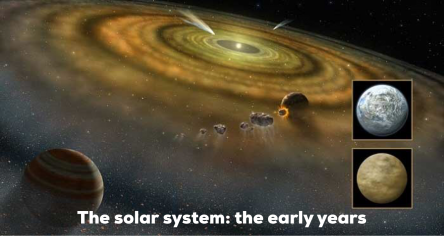 To answer that question, we must journey back in time to around 5 billion years ago to a time when there was no Earth, no Sun, no solar system. Somewhere out in space, there was a huge, amorphous cloud of cold hydrogen gas and dust. In some areas of this vast cloud, the gas and dust tended to bunch up into dense knots. These knots would attain more mass than surrounding sections of the cloud and before long, gravity began to work its magic. For one particular knot, gravity began to pull more and more material together, making it even more dense. As material fell towards the center of the knot, the temperature and pressure at the core became so extreme that the natural tendency for hydrogen atoms to repel one another was overcome and they began to fuse together, creating the heavier element helium and also liberating a great deal of energy in the form of heat and light. At this point, our Sun was born.
To answer that question, we must journey back in time to around 5 billion years ago to a time when there was no Earth, no Sun, no solar system. Somewhere out in space, there was a huge, amorphous cloud of cold hydrogen gas and dust. In some areas of this vast cloud, the gas and dust tended to bunch up into dense knots. These knots would attain more mass than surrounding sections of the cloud and before long, gravity began to work its magic. For one particular knot, gravity began to pull more and more material together, making it even more dense. As material fell towards the center of the knot, the temperature and pressure at the core became so extreme that the natural tendency for hydrogen atoms to repel one another was overcome and they began to fuse together, creating the heavier element helium and also liberating a great deal of energy in the form of heat and light. At this point, our Sun was born.
Surrounding the infant Sun was a giant disc of leftover gas and dust. From out of this material would condense the planets, dwarf planets, moons, asteroids, and comets that make up our solar system family. But the Sun’s powerful gravitational influence created instability in the disc and this turmoil allowed for the shifting orbits of planets and the collisions of young planetismals and protoplanets (objects that were theoretically on their way to becoming full fledged planets). This was a violent time in our solar system’s history and around 4.5 billion years ago, a Mars-sized object that astronomers have named Theia, collided with the infant Earth. This collision resulted in Theia and the Earth melding together, with the exception of some material that got flung out into space and which would eventually come together to form our moon. As a result of this collision, the Earth got knocked off its perpendicular rotational axis by about 23.5 degrees. The stabilizing effect of the moon’s gravity has held it mostly that way ever since.
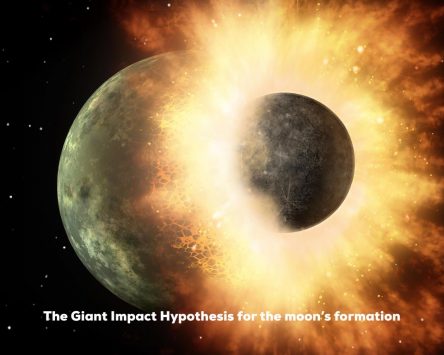 In a roughly 24-hour span of time, the Earth spins once upon its tilted axis. It spins from west to east but the visual illusion this creates is that the Sun, stars, moon, and planets appear to rise in the east and set in the west. As the Sun traces its daily path across the sky we see it increase its altitude from sunrise before reaching its highest point at local noon, and then decreasing in altitude as it heads into afternoon and evening. But there is also an apparent seasonal change in the Sun’s altitude over the course of the year as well, with the Sun appearing higher up in the sky during summer and then becoming lower in the sky during winter. This change in altitude is all due to the Earth’s tilted axis and its ever-changing orientation to the Sun as we make our annual trek around it. The seasonal change in altitude also means that, for most of the year, the Sun does not rise due east or set due west. More on that in just a minute. It is this varying altitude of the Sun and its rise and set points along the horizon in relation to the cardinal points on the compass, that people in the ancient world paid so much attention to in order to create calendars and forecast the seasons.
In a roughly 24-hour span of time, the Earth spins once upon its tilted axis. It spins from west to east but the visual illusion this creates is that the Sun, stars, moon, and planets appear to rise in the east and set in the west. As the Sun traces its daily path across the sky we see it increase its altitude from sunrise before reaching its highest point at local noon, and then decreasing in altitude as it heads into afternoon and evening. But there is also an apparent seasonal change in the Sun’s altitude over the course of the year as well, with the Sun appearing higher up in the sky during summer and then becoming lower in the sky during winter. This change in altitude is all due to the Earth’s tilted axis and its ever-changing orientation to the Sun as we make our annual trek around it. The seasonal change in altitude also means that, for most of the year, the Sun does not rise due east or set due west. More on that in just a minute. It is this varying altitude of the Sun and its rise and set points along the horizon in relation to the cardinal points on the compass, that people in the ancient world paid so much attention to in order to create calendars and forecast the seasons.
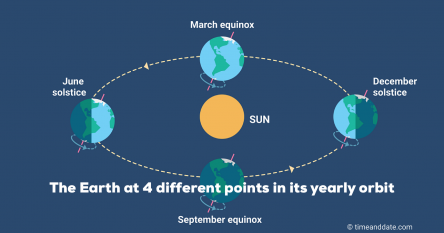 To visualize all this, consult the graphic I’ve included that shows the Earth at four different points in its orbit around the Sun over the course of a year. Over the course of one complete lap around the Sun, you will note in the graphic, that the angle of axial tilt does not change, it’s always at 23.5 degrees. The north and south axis, extended outwards from the poles, always point in the same direction in space (NOTE: over spans of geologic time, the tilt does vary but that’s another story altogether). At this point in time in our planet’s history, the north axis points pretty close to the star Polaris, the “North Star” (this does, has, and will change over time). What does change over the course of a year is the orientations of the globe’s hemisphere’s with respect to the Sun. Take a look at the Earth depicted in the graphic for the month of June. Note how the Northern Hemisphere is pointing towards the Sun while the Southern Hemisphere is pointing away from it. It is at this time that the Sun is highest in our sky here in the Northern Hemisphere and lowest in the Southern. Here in the north, we receive more of the energy that the Sun is radiating out into space from all of that nuclear fusion taking place within its core, and we experience summer. Down south, they are tilted away from the Sun, receiving less solar energy and, so, they experience their winter.
To visualize all this, consult the graphic I’ve included that shows the Earth at four different points in its orbit around the Sun over the course of a year. Over the course of one complete lap around the Sun, you will note in the graphic, that the angle of axial tilt does not change, it’s always at 23.5 degrees. The north and south axis, extended outwards from the poles, always point in the same direction in space (NOTE: over spans of geologic time, the tilt does vary but that’s another story altogether). At this point in time in our planet’s history, the north axis points pretty close to the star Polaris, the “North Star” (this does, has, and will change over time). What does change over the course of a year is the orientations of the globe’s hemisphere’s with respect to the Sun. Take a look at the Earth depicted in the graphic for the month of June. Note how the Northern Hemisphere is pointing towards the Sun while the Southern Hemisphere is pointing away from it. It is at this time that the Sun is highest in our sky here in the Northern Hemisphere and lowest in the Southern. Here in the north, we receive more of the energy that the Sun is radiating out into space from all of that nuclear fusion taking place within its core, and we experience summer. Down south, they are tilted away from the Sun, receiving less solar energy and, so, they experience their winter.
Look back at the graphic again to the dates in March and September. Notice how on these two dates that neither hemisphere is either angled towards or away from the Sun and its rays are now shining down upon the equator, giving both hemispheres roughly equal amounts of both day and night. Here in the Northern Hemisphere, our temperatures tend to become milder compared to the extremes of winter and summer.
 Now, let’s go back and pull some of this information together. If you were to ask most folks in which direction the Sun rises and sets, they will tell you that it’s east and west (dummy!). But they would be wrong. Sorta. Yes, the Sun rises in an easterly direction and sets westwards, but there are actually only two days out of the year where the Sun actually rises due east and sets due west. For other times of the year, the Sun rises and sets south of east/west or north of east/west. Once again, let’s go back to the graphic that shows the Earth at four different points in its orbit around the Sun. On December 21st, if you were outside observing (and you really should if you’ve never done this before) you will notice the Sun rising the furthest south of east and then, later, setting furthest south of west. This is the shortest day of the year and it marks the beginning of winter. December 21st is called the winter solstice (“solstice” is a combination of two Latin words: “sol” = “Sun” and “sistere”, meaning, “stand still”). The Sun remains low in the sky throughout the winter months but it appears to alter its migration southwards on December 21st and slowly begins to head northwards. Six months later, the Sun reaches its most northern point along the eastern horizon at sunrise and then again when it sets north of west later that day. This is the longest day of the year and we call it the summer solstice, the first day of summer. On this day, it appears to stop in its north bound track, turn around, and slowly head southwards until it once again does an about face on December 21st. Throughout the summer months, the Sun rises north of east and then sets north of west.
Now, let’s go back and pull some of this information together. If you were to ask most folks in which direction the Sun rises and sets, they will tell you that it’s east and west (dummy!). But they would be wrong. Sorta. Yes, the Sun rises in an easterly direction and sets westwards, but there are actually only two days out of the year where the Sun actually rises due east and sets due west. For other times of the year, the Sun rises and sets south of east/west or north of east/west. Once again, let’s go back to the graphic that shows the Earth at four different points in its orbit around the Sun. On December 21st, if you were outside observing (and you really should if you’ve never done this before) you will notice the Sun rising the furthest south of east and then, later, setting furthest south of west. This is the shortest day of the year and it marks the beginning of winter. December 21st is called the winter solstice (“solstice” is a combination of two Latin words: “sol” = “Sun” and “sistere”, meaning, “stand still”). The Sun remains low in the sky throughout the winter months but it appears to alter its migration southwards on December 21st and slowly begins to head northwards. Six months later, the Sun reaches its most northern point along the eastern horizon at sunrise and then again when it sets north of west later that day. This is the longest day of the year and we call it the summer solstice, the first day of summer. On this day, it appears to stop in its north bound track, turn around, and slowly head southwards until it once again does an about face on December 21st. Throughout the summer months, the Sun rises north of east and then sets north of west.
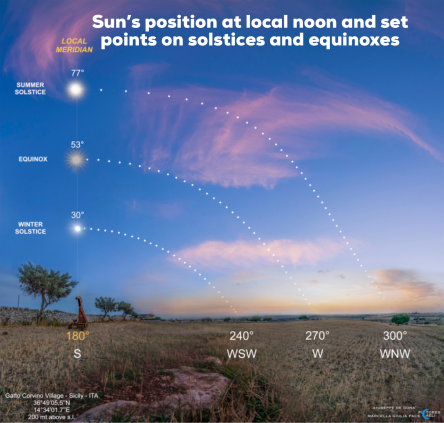 Now, look at the Earth for March and September. Remember, neither of Earth’s hemispheres is now angled towards or away from the Sun, its rays fall directly onto the Earth’s equator and we have roughly equal lengths of both day and night. We call these two days of the year equinoxes (from the Latin meaning “equal night”). The one in March occurs roughly on March 21st, although this year it falls on March 20th. The March equinox is also called the “vernal equinox” (from a Latin word referring to “spring”). The other equinox occurs around September 23rd and it marks the first day of fall. It is sometimes called the “autumnal equinox”. On, or around March 21st, the Sun crosses over the celestial equator (an imaginary line in the sky which is simply the projection of Earth’s equator out into space) as it goes through its apparent migration from its wintertime sojourn in the southern sky towards its northern occupation of the summer sky (for those of us here in the northern hemisphere). It again crosses over the celestial equator in September but headed in the opposite direction. The thing to know here is that as the Sun appears to cross over the celestial equator on these two days of the year, it will appear to rise and set due east and west. Once again, I encourage you to get outside and check this all out for yourself and then track the Sun’s altitude and rise and set points over the course of the year. It’s a rewarding experience, especially if you combine it with regular observations of things such as lunar phases and the nightly motions of the stars across the sky (learn a few star names and constellations each month as well). By doing so, you will gain not only a practical sense of the motion of the sky but how to navigate it as well (a useful thing if you ever decide to own a telescope). Another benefit from such sky watching activities is that, with practice and repetition, you will begin to gain a certain mindfulness, or awareness of both you and the universe around you. In other words, you can regain a connection with Nature on the grandest of scales, something our ancestors were far more in tune with than we are today.
Now, look at the Earth for March and September. Remember, neither of Earth’s hemispheres is now angled towards or away from the Sun, its rays fall directly onto the Earth’s equator and we have roughly equal lengths of both day and night. We call these two days of the year equinoxes (from the Latin meaning “equal night”). The one in March occurs roughly on March 21st, although this year it falls on March 20th. The March equinox is also called the “vernal equinox” (from a Latin word referring to “spring”). The other equinox occurs around September 23rd and it marks the first day of fall. It is sometimes called the “autumnal equinox”. On, or around March 21st, the Sun crosses over the celestial equator (an imaginary line in the sky which is simply the projection of Earth’s equator out into space) as it goes through its apparent migration from its wintertime sojourn in the southern sky towards its northern occupation of the summer sky (for those of us here in the northern hemisphere). It again crosses over the celestial equator in September but headed in the opposite direction. The thing to know here is that as the Sun appears to cross over the celestial equator on these two days of the year, it will appear to rise and set due east and west. Once again, I encourage you to get outside and check this all out for yourself and then track the Sun’s altitude and rise and set points over the course of the year. It’s a rewarding experience, especially if you combine it with regular observations of things such as lunar phases and the nightly motions of the stars across the sky (learn a few star names and constellations each month as well). By doing so, you will gain not only a practical sense of the motion of the sky but how to navigate it as well (a useful thing if you ever decide to own a telescope). Another benefit from such sky watching activities is that, with practice and repetition, you will begin to gain a certain mindfulness, or awareness of both you and the universe around you. In other words, you can regain a connection with Nature on the grandest of scales, something our ancestors were far more in tune with than we are today.
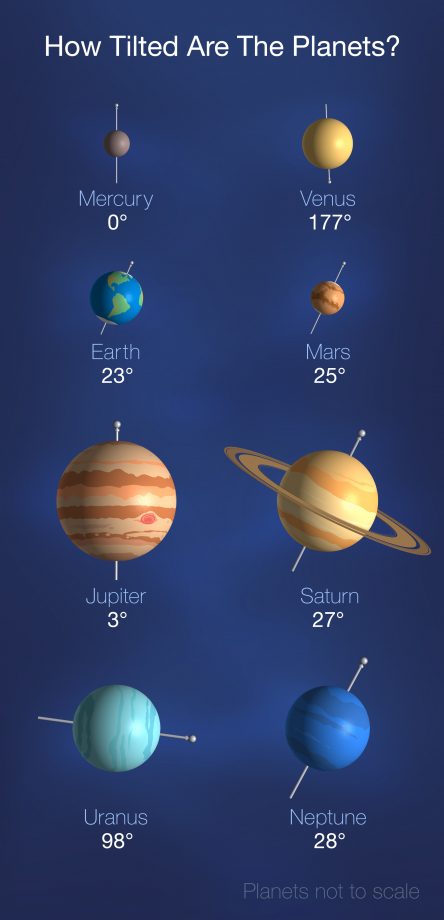 Consider this when you are observing the sky over the course of the four seasons (or if you are just out and enjoying a nice walk on a temperate spring day): while every planet in our solar system experiences some kind of seasonal change, there are several for which that change is negligible. I mentioned earlier that the Earth’s varying distance from the Sun does not play a role in determining our seasons and that’s true enough but it’s not necessarily true for the other planets in our solar system. The size of a planet’s orbit, the size of the planet itself, its atmosphere (if it has one), and its degree of axial tilt are all contributing factors to a planet’s seasons. Take for instance Venus. Venus, with its runaway greenhouse effect, 900-degree Fahrenheit surface temperature, and sulfuric acid laced clouds is not a very pleasant place to visit. Venus tilts upon its axis by only about 3 degrees and while it has seasons, there is little to distinguish them apart from one another. Neptune, the 8th and outermost planet in the solar system, tilts upon its axis by 28.5 degrees, not too different from our own. The gas giant planet does have distinct seasons but there are some notable factors that influence them. For one, Neptune is placed so far away from the Sun that any energy it receives from is going to be rather paltry. However, Neptune’s core generates a lot of heat and it is this that drives most of the planet’s weather. Since it takes Neptune almost 165 of our years to complete just one trip around the Sun, each season lasts for about 41 Earth years. Life on Earth has evolved on a world with a 23.5-degree tilt, which is held fairly constant by the gravitational interaction with its only natural satellite (itself the product of a chance collision with the infant Earth 4.5 billion years ago), at a Goldilocks distance from its parent star where temperatures are just right to contain liquid water and moderate temperatures. Who can say how, or if, life might have evolved if conditions were otherwise. Food for thought as you gaze up into the skies of blue-green planet Earth in both awe and wonder.
Consider this when you are observing the sky over the course of the four seasons (or if you are just out and enjoying a nice walk on a temperate spring day): while every planet in our solar system experiences some kind of seasonal change, there are several for which that change is negligible. I mentioned earlier that the Earth’s varying distance from the Sun does not play a role in determining our seasons and that’s true enough but it’s not necessarily true for the other planets in our solar system. The size of a planet’s orbit, the size of the planet itself, its atmosphere (if it has one), and its degree of axial tilt are all contributing factors to a planet’s seasons. Take for instance Venus. Venus, with its runaway greenhouse effect, 900-degree Fahrenheit surface temperature, and sulfuric acid laced clouds is not a very pleasant place to visit. Venus tilts upon its axis by only about 3 degrees and while it has seasons, there is little to distinguish them apart from one another. Neptune, the 8th and outermost planet in the solar system, tilts upon its axis by 28.5 degrees, not too different from our own. The gas giant planet does have distinct seasons but there are some notable factors that influence them. For one, Neptune is placed so far away from the Sun that any energy it receives from is going to be rather paltry. However, Neptune’s core generates a lot of heat and it is this that drives most of the planet’s weather. Since it takes Neptune almost 165 of our years to complete just one trip around the Sun, each season lasts for about 41 Earth years. Life on Earth has evolved on a world with a 23.5-degree tilt, which is held fairly constant by the gravitational interaction with its only natural satellite (itself the product of a chance collision with the infant Earth 4.5 billion years ago), at a Goldilocks distance from its parent star where temperatures are just right to contain liquid water and moderate temperatures. Who can say how, or if, life might have evolved if conditions were otherwise. Food for thought as you gaze up into the skies of blue-green planet Earth in both awe and wonder.